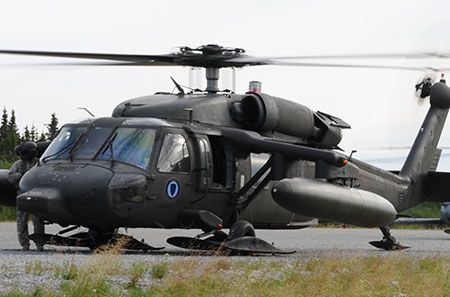UH 60 Helicopter Maintenance: A Comprehensive Guide for Pilots
UH 60 Helicopter Maintenance: A Comprehensive Guide for Pilots
Blog Article
Recognizing the Mechanics and Engineering Behind Uh 60 Helicopters
The UH-60 helicopter, generally recognized as the Black Hawk, stands as a peak of modern-day rotorcraft technology, embodying a mix of robust design and intricate mechanics. As we peel back the layers of the UH-60's style, a globe of intricate systems and meticulous engineering comes to light.
Background of UH-60 Helicopters
The history of UH-60 helicopters traces back to the late 1970s when the United States Military looked for a advanced and flexible utility helicopter to change its aging fleet. In feedback to this requirement, the Sikorsky Aircraft Firm established the UH-60 Black Hawk helicopter. Introduced in 1979, the UH-60 quickly came to be a staple in armed forces operations as a result of its outstanding abilities.
The UH-60 was designed to master a range of missions, consisting of army transportation, medical discharge, electronic war, and unique procedures. Its capacity to adapt to various functions made it a valuable property to the U.S. uh 60. Military and other army forces around the world
For many years, the UH-60 system has actually undergone numerous upgrades and variants to improve its performance and equal advancing mission needs. These helicopters have seen extensive service in disputes such as the Gulf Battle, Afghanistan, and Iraq, showcasing their reliability and convenience in varied functional atmospheres. The UH-60's rich history is a testimony to its long-lasting legacy as a leading energy helicopter.

Engine and Power Systems
Using advanced propulsion technology, UH-60 helicopters are furnished with sophisticated engine and power systems to guarantee optimum performance and integrity in a series of operational situations. The UH-60, typically called the Black Hawk, is powered by 2 General Electric T700-GE-701D engines, each with the ability of supplying up to 1,940 shaft horsepower. These turboshaft engines offer the essential thrust for the helicopter to accomplish its missions effectively, consisting of army transportation, clinical evacuation, and battle support.

Blades System and Aerodynamics
Exactly how do the rotor system and the rules of aerodynamics of UH-60 helicopters add to their operational performance and flight abilities? The blades system of the UH-60 helicopter plays an essential function in providing lift and propulsion. The UH-60 includes a four-bladed, completely expressed blades system that enables high ability to move and stability during trip. This style allows the helicopter to perform a vast array of objectives, from transportation and clinical emptying to combat Recommended Reading procedures.
The rules of aerodynamics likewise play a crucial function in the efficiency of you could check here UH-60 helicopters. The streamlined body and rotor blade style lower drag, enabling the helicopter to accomplish higher speeds and better fuel performance. The aerodynamic design of the UH-60 additionally contributes to its ability to operate in diverse environmental conditions, including high elevations and hot temperature levels.
Avionics and Flight Control Systems

In its elaborate coordination with the blades system and aerodynamics of UH-60 helicopters, the avionics and flight control systems develop a crucial network of innovations shaping the airplane's functional capabilities. Avionics encompass the digital systems made use of for interaction, navigating, and keeping an eye on different aircraft functions. In the UH-60, these systems include digital display screens, interaction radios, general practitioner navigation, weather radar, and autopilot systems. These avionics systems provide important info to the pilots, enhancing situational understanding and making certain secure and effective operation of the helicopter.
The flight control systems of the UH-60 are accountable for equating the pilot's inputs right into the ideal adjustments to the rotor system, ensuring stable flight and maneuverability. These systems include hydraulic actuators, servos, and computers that work together to manage the tail and primary rotors, in addition to various other trip control surface areas. By specifically taking care of the helicopter's trip characteristics, these systems enable pilots to carry out a vast array of objectives, from transport and search-and-rescue to deal with operations, with accuracy and view self-confidence.
Function and Applications in Aeronautics
Avionics systems in UH-60 helicopters encompass a variety of electronic systems that aid in navigation, interaction, tracking, and regulating various airplane features. These systems include electronic displays, autopilot systems, interaction radios, GPS navigation equipment, and weather condition radar. In addition, these systems include safety functions such as auto-pilot modes, terrain awareness advising systems, and stability augmentation systems to boost the total safety and functional abilities of the UH-60 helicopters in numerous missions, including troop transportation, clinical discharge, search and rescue, and aerial firefighting.
Conclusion
Finally, the UH-60 helicopter is a flexible aircraft with a rich background and advanced engineering. Its engine and power systems, blades system, the rules of aerodynamics, avionics, and trip control systems all work together to make it a reliable and reliable device. The UH-60's duty and applications in aeronautics are vast, ranging from military operations to browse and save goals. Its proceeded growth and usage demonstrate its significance in the field of air travel (uh 60).
In its detailed sychronisation with the rotor system and aerodynamics of UH-60 helicopters, the avionics and flight control systems create a vital network of technologies shaping the aircraft's operational capacities.The flight control systems of the UH-60 are liable for equating the pilot's inputs into the appropriate modifications to the blades system, making certain secure trip and maneuverability. Avionics systems in UH-60 helicopters encompass an array of electronic systems that help in navigating, communication, tracking, and controlling different airplane functions. In addition, these systems incorporate safety functions such as auto-pilot settings, terrain awareness alerting systems, and stability enhancement systems to improve the general safety and security and functional abilities of the UH-60 helicopters in various goals, including army transport, clinical discharge, search and rescue, and airborne firefighting.
Its engine and power systems, rotor system, the rules of aerodynamics, avionics, and flight control systems all function together to make it a efficient and reputable machine.
Report this page